by Alice Connolly O’Brien // Feb. 4, 2022
Liz Rosenfeld is a Berlin-based artist whose work blends a multitude of disciplines. Experimenting with different media, Rosenfeld dissects and pushes the boundaries of the contemporary queer experience and its modes of storytelling. Their latest project, ‘White Sands Crystal Foxes,’ will be presented as a 360° interactive experience at the Zeiss Groß-Planetarium this month, as part of Berlinale’s Forum Expanded program. We spoke with Rosenfeld about their connection to Berlin, their creative process across analog and digital production, and their long-term film project, ‘Foxes,’ a queer coming-of-age story set in the wake of a world-altering climate catastrophe.
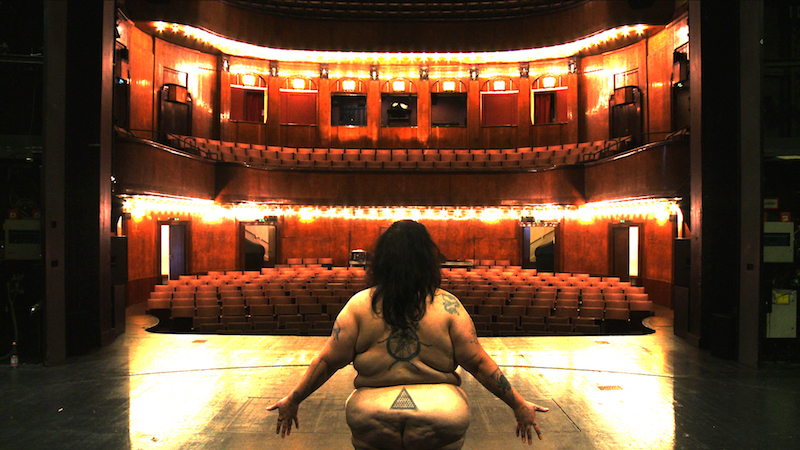
Liz Rosenfeld: ‘Glimpse of Manipulated Still,’ Hebbel am Ufer theater, Berlin, still image series // Courtesy of the artist
Alice Connolly O’Brien: Your body of work weaves through the sustainability of emotional and political ecologies, cruising methodologies and queered renditions of past and future histories. As an artist who lives and creates in Berlin, how has the city acted as a source of inspiration for these themes?
Liz Rosenfeld: Berlin has always felt like an unfinished city existing within a non-linear, disorienting notion of time and space. A city of social traumas that are simultaneously deeply present and invisible. A city of ruins that exist in both the past, present and future. A city of narrative fragments. A city of ghosts and myths. A city that can’t quite catch up with itself. And a city full of both local and international people who are searching, questioning, existing in various states of both physical and emotional migrations. I came to Berlin 14 years ago with the intention of making my first international film project, which became ‘The Surface Tension Trilogy.’ However, I also arrived here in search of catharsis, as a second mourning process, after the death of my mother, who was the daughter of German Jews and Holocaust survivors, one of whom (my Oma) grew up in Berlin. I always say that I came to Berlin as a queer with the desire of finding a Jewish diaspora I never knew or was always kept a secret from me, but instead I found a queer diaspora I never expected. Within my tiny corner of community, I experienced an intersection of queer positions, stories and lives that found each other and, at the time, started to create modalities and systems of working outside of institutional artistic production and support, in order to tell stories both in front of and behind the camera and performance space.
My work deals with all kinds of questions relating to how nostalgia is weaponized as a tool of historical and emotional manipulation, through queering anachronistic modalities of storytelling. I continue to be inspired and held by the various shifting political landscapes of Berlin, and how I continue to contend with my own decision to make Berlin my home as a radical queer American/German Jew, making experimental film, performance, written and visual artworks. I think Berlin is an extremely inspiring city full of historical and political contradictions, in that many of the people who inhabit this city, in their own ways, are dreamers, and yet the dichotomies between race, class and histories lived in Berlin are compacted political contradictions, on many levels.
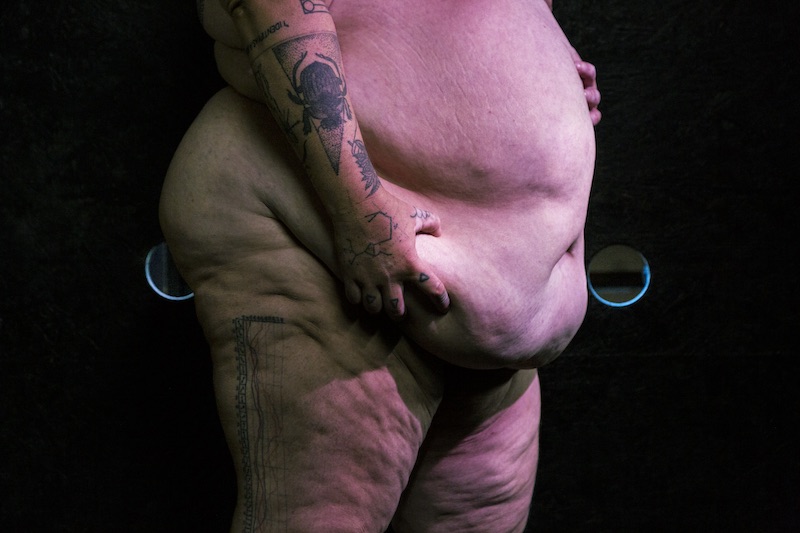
Liz Rosenfeld: ‘Tremble,’ 2020, still // © Photo by Christa Holka
ACO: Over the years you have displayed a knack for showcasing some of these themes on film. What inspires you to take human subject matters—such as the queer experience, relationships and even flesh itself—and reinterpret them cinematically?
LR: As an artist who works across a lot of different genres and materials that address the same questions and desires related to a queer corporal position, I really consider my film work as an extension of my performances, writings, drawings and installations, creating both a metaphorical and literal body that is in perpetual growth and experiences many transitions. I have always considered and treated film as flesh itself, thinking about both the “skin” of actual film stock, as well as the digital texture of video as fleshy material absorbing and relaying stories, ideas and desires. I work with moving images as performative bodies, in that I am inspired by the unpredictability of materiality and how even in the most controlled, organized and planned systems and environments (like film sets and theaters, for example) the body continues to be leaky, unpredictable and dismantled. I love how creating moving images continues to surprise, teach and push me, in the same way that creating performance does. There is always an unknown element that can tip the whole balance of the image, and it’s these moments I really live for as an artist.
ACO: As part of Berlinale this year, you will be showcasing a new experimental cinema work titled ‘White Sands Crystal Foxes,’ which will provide viewers with a 360° experience. How does it feel to interpret a subject into something digital compared to an in-person performance or piece of writing? Has creating digital art that’s wholly immersive given you additional artistic freedom?
LR: When I started to develop ‘White Sands Crystal Foxes,’ I was having dinner with my friend Maria and she asked me: “If you could make a work for any space, what would it be?” And I immediately answered: “a planetarium.” For me, an immersive experience like this really brings together my love for the cinematic and the performative, in that even though the images/bodies we are experiencing are digital, the performative immersion is the experience of sitting in this kind of 360° environment with other live bodies.
In the film itself—and in a lot of my other work—I get deep into the scientific, philosophical and emotional relationships I have with holes. Holes as portals, pores, thresholds and physical manifestations of un-fillable desire. How do holes conduct energy? How do they serve all kinds of nature bodies, and how do bodies submit to different kinds of holes? In this work, I also zoom out and look at the planetarium as a hole—a structure where bodies meet together—and what happens in the moment of meeting and filling this space (hole) together. How does the planetarium itself become a structure for desire to be encountered? How does it become a cruising space? How do bodies feel each other as they watch this sensual, political, daydream of an experimental film? It was exciting to develop and create this work, having to consider a key element while we were shooting and editing it: the space of the planetarium itself as part of the narrative joinery of this short film. I have never made a film for a specific kind of structural viewing experience before, and I found this extremely inspiring.
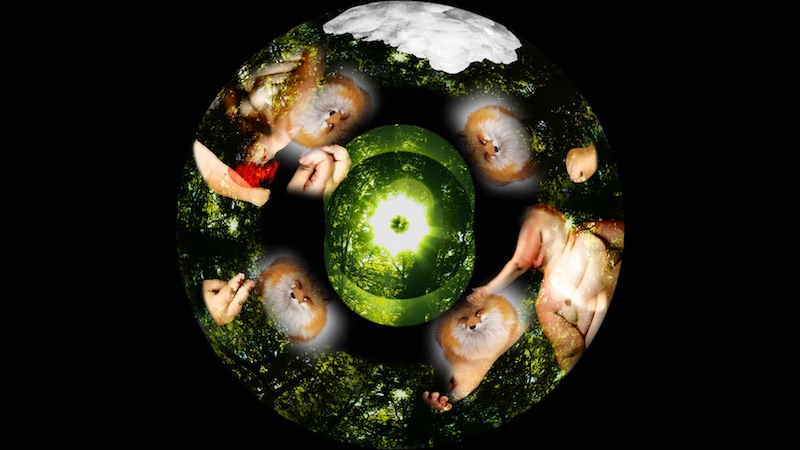
Liz Rosenfeld: ‘White Sands Crystal Foxes,’ film still // Courtesy of the artist
ACO: ‘White Sands Crystal Foxes’ marks the end of a seven-year period of creative research for your first feature film, which will be titled ‘Foxes.’ The film will follow a young queer protagonist as she grapples with her own identity in the wake of a global energy crisis that has left human bodies as the main source of energy and foxes as the only life form on the planet procreating. What inspired you to begin this project?
LR: The inspiration for this project is an intersection for my extreme love and obsession with coming of age/young adult/teen movies and science fiction. As a visual and performance artist who has only created experimental narratives through performance, moving images and different kinds of material, I wanted to challenge myself to write my dream coming-of-age queer feature film. I co-wrote the script for ‘Foxes’ with filmmaker and scriptwriter Thais Guisasola, who has a lot of experience in writing her own feature films, as well as writing for other films and television.
We wrote ‘Foxes’ five years ago, and besides looking at how a queer coming of age could be told in relationship to a world in climate crisis, one of the main parts of the story is how a virus is infecting humanity, but rather than killing humans, it is making them valuable subjects who, when infected with the virus, in heightened states of emotion, produce crystals from whatever bodily fluids are excreted. These crystals are believed to be extremely valuable sources of energy, sources that could solve the global energy crisis. So this film is really about how a virus is queered in relationship to living in a different way, rather than dying because of who one is in the world, as the narrative of sickness traditionally prevails in queer stories. Of course, in the age of Covid, any story about a virus takes on another level of responsibility in how we approach it, and I think this is one reason I have been going slow with this project. We are thinking about how to tell this viral story with a new added sensitivity toward what people have experienced.
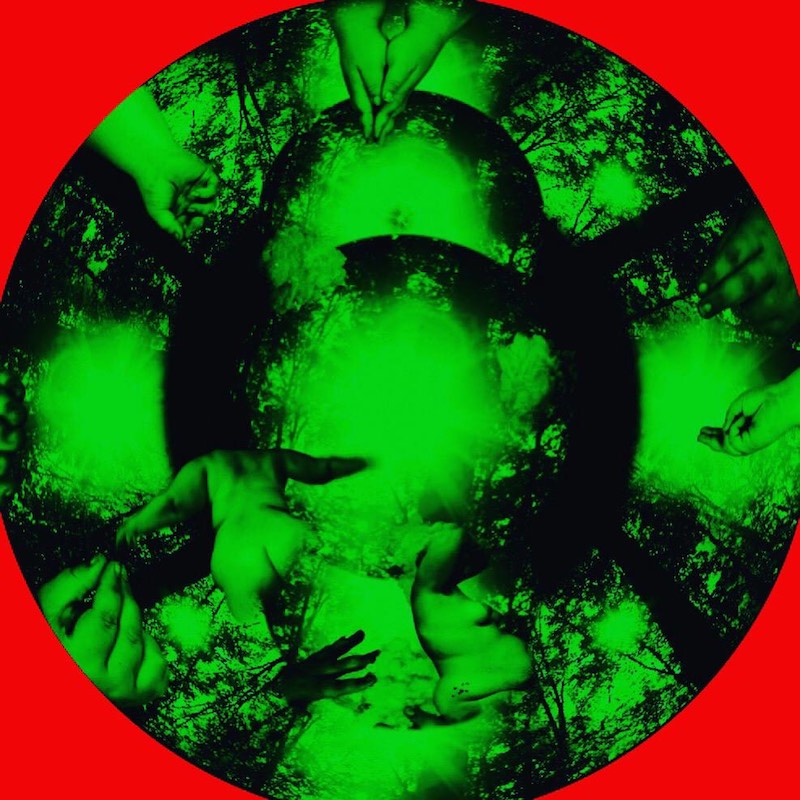
Liz Rosenfeld: ‘White Sands Crystal Foxes,’ film still // Courtesy of the artist
ACO: What was it about foxes that triggered you to pinpoint them as the sole procreators on Earth?
LR: To be honest, the root of my fox obsession comes from a time when I was very in love in a queer-teen-romance kind of way. One afternoon, my crush and I went on a walk in the forest and took some psychedelics. While we were sitting by the banks of the river, we both happened to look over our shoulders at the same time, and right in front of us was a fox. What was probably a few seconds felt like an eternity and I became convinced that this fox was some sort of future sign. I then went deep into research regarding the traits and lives of foxes, how they are one of the only mammals that exist all over the world in a myriad of extreme climates. Their scavenger/survivor instincts. How they form families. Their social queer behaviours. And also, how foxes are animals that live among humans, as well as in deep nature.
I visited fox rescue centers, spoke with fox specialists, conservationists and scientists. I went to a specific fox conservatory in the mountains of Japan, where cinematographer Imogen Heath (DP for ‘White Sands Crystal Foxes’) and I spent two days shooting videos of foxes. So, I thought, how would humans react to a species that they already consider to be “invasive” becoming the only mammals procreating, taking over? What could humanity potentially learn from the way foxes live and survive? Foxes are really part of setting the scene and narrative in the film. I am even considering the possibility that an actual fox doesn’t even get seen in the film,: it’s just the knowledge of feeling that they are always around, and moving in.
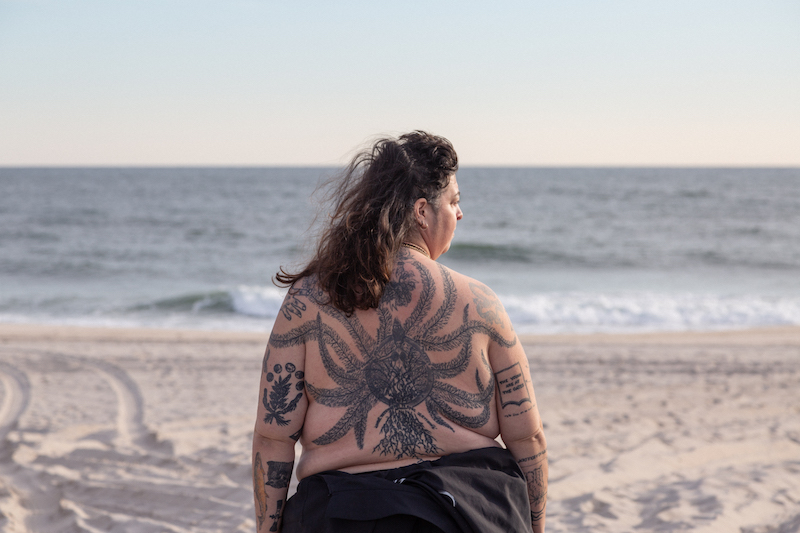
Liz Rosenfeld: ‘Dolphin Beach,’ still // © Photo by Christa Holka
ACO: Your creative research for ‘Foxes’ has been eclectic, vivid and indicative of a creator who is building a rich and complete world. Had you always intended on pursuing a research period of this length and how, having completed all these associated projects, do you feel in the wake of producing the feature film itself?
LR: As I am an artist who often works slowly with larger projects and needs deep research time to understand the questions and stories I am engaged with, I decided that I need to really understand why I want to make ‘Foxes.’
‘White Sands Crystal Foxes’ is the third significant and final work in this research phase of the last seven years. As the first two were performance works I made for the stage, I wanted to create an experimental cinematic experience as the culminating exploration before I embark on making the feature film ‘Foxes.’ Continuing to engage with the material and ideas over such a long period has also given me the time to expand on the themes and stories we are building. The script has changed and will continue to change, right up until I have the opportunity to finally make it. Thais and I have talked about how we could also see ‘Foxes’ as an episodic limited series, or even a trilogy.
We are not married to a feature film format, even though making a feature is a major bucket list dream of mine. I am also considering changing the main protagonist to a middle-aged person coming of age, like myself, as another way to consider how queer people can go through transitions and different kinds of coming out at any stage in life. So, we will go back to the script and consider the small adjustments and tweaks we are ready to make, and then dive into the next phase of this project. I do hope that this phase entails finally seeing ‘Foxes’ make it to the screen.
This article is part of our feature topic of ‘Digital.’ To read more from this topic, click here.
Artist Info
Screening Info
Berlinale Forum Expanded
Liz Rosenfeld: ‘White Sands Crystal Foxes’
Screenings: Feb. 13, 2022; 9:30pm and Feb. 15, 2022; 7pm
berlinale.de
Zeiss-Großplanetarium, Prenzlauer Allee 80, 10405 Berlin, click here for map






















